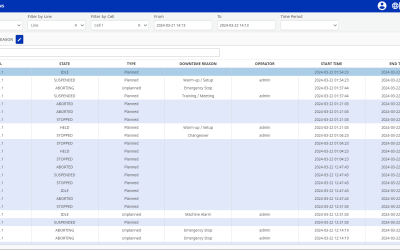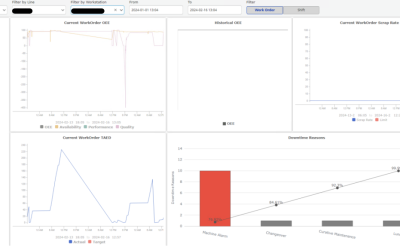Automation Engineer
“The problem is that, at the core, this system is old, which means that it fits the world as it was 20 years ago”.
Whether you’re the engineer that has to deal with complex and manual tasks or the leader who has to spend hundreds of thousands on an outdated SCADA, the above statement may be frustratingly familiar to you.
And if you’re here, it means you’re looking for something different. Smarter. Cheaper, for crying out loud.
We would urge you to read on. Is this blog post even worth your time? Probably not. Few things really are. Might as well go have a cold beer and spend time with your loved ones instead.
But if you go to work tomorrow and you’ll meet a SCADA system that makes your job harder, you might find this blog post useful.
Table of Contents
Play around with our 3-minute demo of a beer brewing process.
Oh, no, not another SCADA mess, please
We know. Stay with us for a second, though, will ya?
Here’s what a SCADA solution provider told one of our clients:
“Forget the license price, it’ll drown in engineering”.
First of all, the arrogance in that statement is ridiculous.
Second of all, and the most important thing: to advocate for the amazing benefits of digital transformation, but to talk about the enormous engineering costs of implementing them, all in the same breath… that’s just heartbreaking. It completely misses the point.
From the client’s perspective, there are two different types of investments related to any SCADA project: license cost and engineering.
There are SCADA software platforms available with a fair and competitive license cost. In Enuda, we use Ignition, with a transparent and attractive license model.
On the engineering part, we need to up the game. We need standard solutions, scalable solutions, and a rigorous roadmap (or modus operandi, if you will) for implementation. The aim must be to reduce the engineering cost and, thus, the risk for you, the client.
That’s why this is not just another SCADA solution. This is the combination of Ignition SCADA’s drop-dead-gorgeous license price model and Enuda’s quest to:
- reduce engineering costs
- and make an efficient, simple, and effective SCADA solution accessible to everyone.
What’s SCADA by Enuda anyway?
Let’s agree on what SCADA is first, because we know different people call it different things.
The acronym “SCADA” means Supervisory Control and Data Acquisition, and it’s a software solution in an industrial context. SCADA solutions come in all shapes and sizes, from small and simple to large and complex. SCADA solutions control processes, record events, gather and process industrial data, monitor processes, and notify operators.
In short, it’s a vital and valuable software solution in almost all industrial processes. It contributes to higher efficiency, reduced downtime, and a safer production environment.
Life is just too short for lousy or expensive SCADA solutions. Don’t you agree?
In our quest to deliver a suitable SCADA at a fair price point, we created SCADA by Enuda.

Essentially, it’s a toolbox with the sole purpose of giving you a working SCADA solution faster.
The toolbox consists of the basic building blocks needed for most SCADA solutions we have met. Think about it as a LEGO kit, where the individual parts fit together, and you can build many solutions.
You need two things for your SCADA solution:
- A flexible and scalable software platform
- Engineering to get everything connected and build the HMI (Human Machine Interface – the screens).
And that implies a trade-off.
On the one hand, the software platform must be as flexible, scalable, and versatile as possible. That means having an open playing field for future needs.
On the other hand, you want to keep engineering costs as low as possible. That means reducing customisation as much as possible.
Somehow, you have to compromise on this trade-off. You either accept less flexibility and scalability or higher customisation costs.
The design of SCADA by Enuda gives you the best possible compromise in that trade-off.
In more human terms, we hear that “I don’t want a fixed product that locks me in and brings no future flexibility.” And in parallel. We hear that, “but on the other hand, I don’t have the budget for thousands of engineering hours.”
We built SCADA by Enuda to provide the flexibility you need AND keep engineering costs low.
How do we do it?
We use the Ignition software platform from Inductive Automation to build SCADA solutions. Ignition is a software platform that meets the requirements of any modern SCADA. They built it on open standards and it integrates seamlessly with SQL, Python, CSS3, and html5.
It’s modular, which means you can add exactly the business functionality needed. it’s flexible and scalable, and last but not least, built for mobile-first thinking.
The license model for Ignition is equally attractive with its one-time license fee. For you, as the end-user, Ignition offers an attractive package of flexible modularity, an unlimited number of tags, users, and devices in combination with a one-time license fee. Buy precisely what you need, when you need it, and only what you need to get started.
So, we nailed down that you need a flexible and scalable software platform for your SCADA and the engineering to get things running. Ignition covers your need for a software platform at an attractive price point, which leaves the engineering part to worry about.
The question is: how to bring down the engineering cost related to your SCADA implementation? Another way of asking is: how to get the best possible outcome out of the trade-off between remaining flexible and reducing customisation as far as it goes?
To answer, let’s open the box, see what’s in there.
What’s in the box?
What do you need to build a basic SCADA system?
Some basic building blocks together cover the basics of any SCADA solution. Most, if not all, industrial processes have standard components like pumps, motors, valves, and PID controllers.
Additionally, all SCADA solutions contain alarming functionality at the core. And all SCADA solutions need at least some form of HMI (Human-Machine Interface). Finally, all SCADA solutions need some coding and tag structure to pull it all together into one coherent solution that’s easy to scale and maintain.
To reduce engineering costs, we created these basic building blocks. We made standard components, faceplates, and all the necessary logic behind the scenes for:
- Motor
- VFD motor (variable-frequency drive)
- Valve actuator
- Valve actuator with position
- Analog value
- Digital indicator
- PID controller
We also made all the necessary alarming and status logic on these components to work right out of the box. As the icing on the cake, we wrapped an intuitive navigation functionality around the whole thing.
Here are some snippets, but the real fun is in our demo:



These basic building blocks make up the backbone of most industrial processes.
The Ignition platform comes with some powerful tools that we have added to the toolbox. We have access to the standard Ignition alarming overview, both real-time and historically. We also use the Ignition Power Chart, which allows historical trend analysis and simple statistical reporting.
SCADA by Enuda is continuously evolving, just like we are, so we’re constantly refining the delivery. One thing is clear, though: a clear action plan, almost plug-and-play elements, and much lower costs and risks come with the package.
We know, screenshots and text are kinda boring.
Let’s have some real action.
Wrap up
What does this mean? It means that you can finally have a SCADA solution that doesn’t make you go crazy because of how difficult and expensive it is to get it done.
Furthermore, it means that the risks that used to be involved with changing your SCADA or starting from scratch are no longer that scary because:
- All we do is Ignition. We’re pretty darn good at it because we made that decision on day 1. Moreover, we’ve had pretty amazing, successful SCADA projects.
- Way less money on the table for the license (one-time cost!) and engineering.
- No more running around like madmen trying to figure out what’s needed, what the goals are, and how to achieve them. We have a solid starting point and a plan, built from experience, on how to get it done.
How to get started
Alright, all of this doesn’t sound so bad, but how do you get started? What is the best way to get started on building a modern SCADA solution?
Our recommendation is always the same: start as small as possible. The toolbox provides the basic building blocks to get started, and with the in-built scalability of the Ignition platform, you are good to go.
When you have decided on an industrial process for a small pilot project, we aim for two milestones or success criteria:
- Connectivity – can we connect Ignition to the devices and see real-time values?
- HMI – meaning can we swiftly build a simple HMI showing some real-time values?
With these two milestones reached, you have proof of concept.
Now it’s time to rock&roll and build valuable SCADA solutions, one process at a time.
Find out more about SCADA by Enuda:


